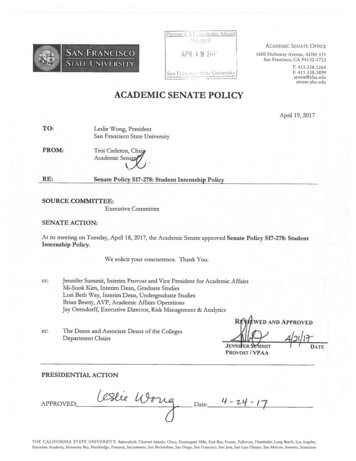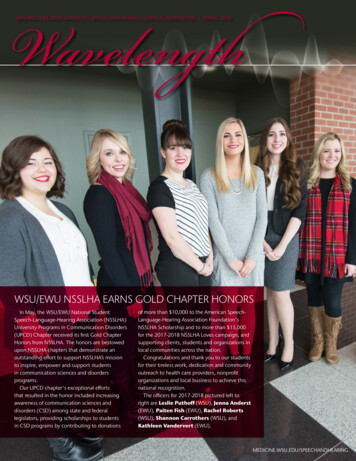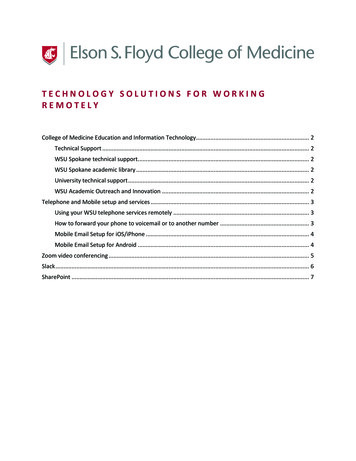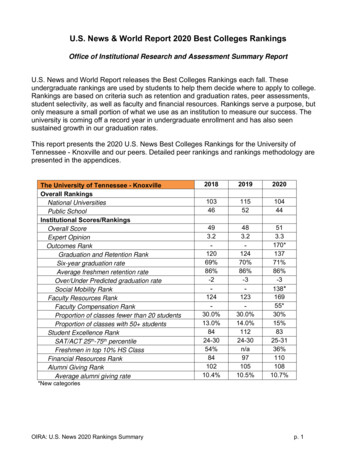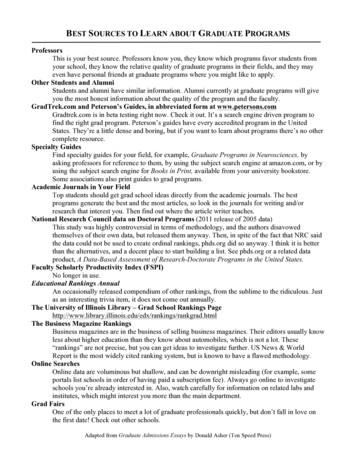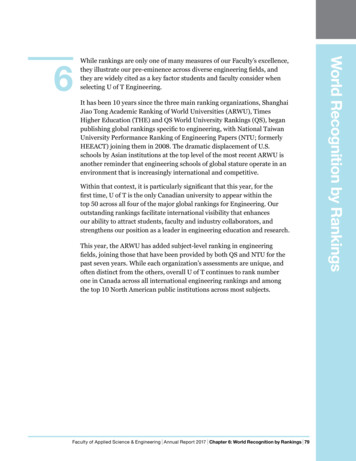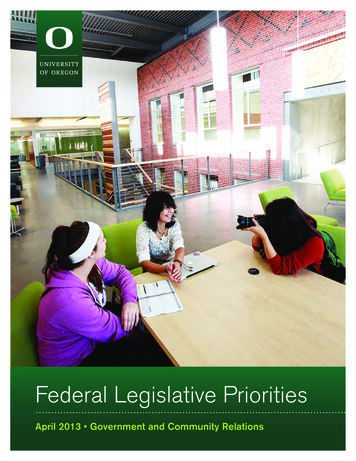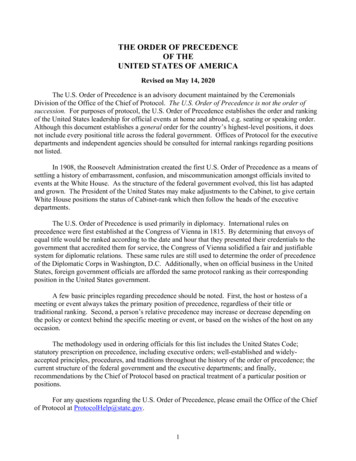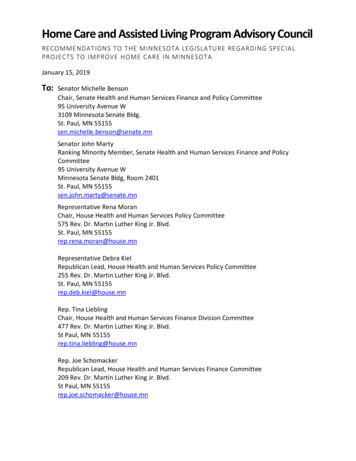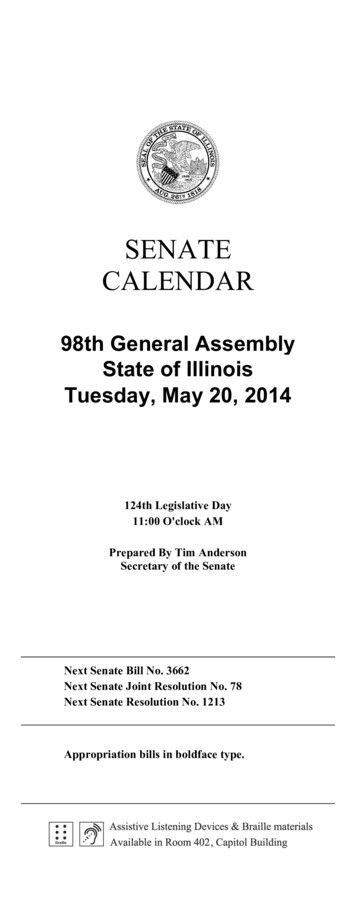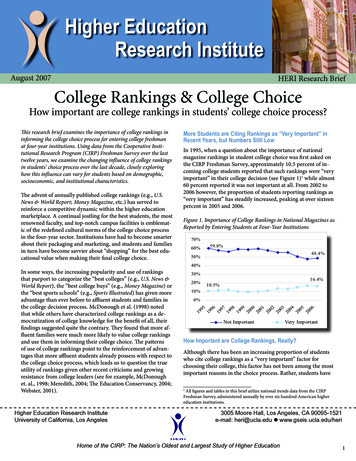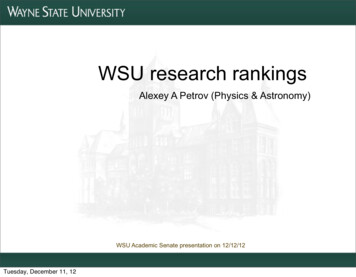
Transcription
WSU research rankingsAlexey A Petrov (Physics & Astronomy)WSU Academic Senate presentation on 12/12/12Alexey A PetrovTuesday, December 11, 12
Instead of introduction: a friend’s e-mail This summer I got an e-mail from my friend in Russia, whoworks at one of Russian research universities:– “Have you heard that last year our Ministry of Education and Researchwent through an exercise to determine the list of Universities whosediplomas would be accepted in Russian Federation without the lengthyprocedure of "confirmation"? Why is your university not on that list?” In order to answer this, I needed their “criteria for inclusion”– the mechanism for the selection was simple: they chose three widelyaccepted rankings of world universities, the Academic Ranking of WorldUniversities (ARWU), THE World University rankings (TWUR), and QSWorld University Rankings (QSWUR) that rank universities according totheir research output and other characteristics. In order for a Universityto be on the RF "approved" list, that University had to be ranked in thetop 300 in ALL three lists. This lead to a more general question: how does WSU fare inresearch rankings? What are ranking criteria?Alexey A PetrovTuesday, December 11, 122
Rankings schemes Different rankings schemes serve different purposes– research aggregate rankings– research expenditures rankings Research Aggregate Rankings– usually use a weighted combination of “hard data,” such as quantity ofpublication/citations, and “soft data,” such as results of a survey– sources and weight of data differentiate among the ranking schemes– use of survey is controversial (popularity contest?) Research Expenditure Rankings– this is the least controversial ranking scheme based on the reportedamount of research expenditures of a university– done by National Science Foundation (NSF), but counts all sources ofincomeAlexey A PetrovTuesday, December 11, 123
Research aggregate rankingsThree most reputable schemes– Academic Ranking of World Universities– Times Higher Education World University Rankings– Quacquarelli Symonds World University RankingsAlexey A PetrovTuesday, December 11, 124
ARWU Academic Ranking of World Universities (ARWU)– has been published by Shanghai Jiao Tong University/Shanghai RankingConsultancy since 2003 Selection criteria for inclusion to ARWU– universities with faculty/stuff who are Nobel Laureates, Fields Medalists,Highly Cited Researchers, or with papers published in Nature or Science.– universities with significant amount of papers indexed by Science CitationIndex and Social Science Citation Index (available through Web Of Science)– more than 1200 universities are ranked and the best 500 are published onthe web. Each University is scored on a set of indicators– For each indicator, the highest scoring institution is assigned a score of 100,and other institutions are calculated as a percentage of the top score.Alexey A PetrovTuesday, December 11, 125
Indicators & Weights for ARWUAlexey A PetrovTuesday, December 11, 126
ARWU: Comparative rankAlexey A PetrovTuesday, December 11, 127
ARWU: WSU performanceAlexey A PetrovTuesday, December 11, 128
WSU is reasonably ranked in some broad subject fields WSU is reasonably highly ranked by ARWU in some fields . but it is hard for Chemistry or Physics to compete with larger departments atother institutions (e.g. Physics: 29 faculty at WSU vs 67 at MSU)Alexey A PetrovTuesday, December 11, 129
Times HigherEducation THE World University Rankings– has been published (with Thomson Reuters publications data engine World ofScience) by the Times since 2010 Selection criteria for inclusion to THE WUR– universities that publish more than 200 papers a year– out of those, rankings of 400 best universities are published Each University is scored on a set of 5 indicators– for each indicator there are several separately weighted subcategories– an important part is paper citation analysis done by Thomson Reuters– the data are aggregated into columns according to its Z score, an indicator ofhow far removed any institution is from the average.Alexey A PetrovTuesday, December 11, 1210
Indicators & weights for THEWURAlexey A PetrovTuesday, December 11, 1211
THEWUR: Comparative rankAlexey A PetrovTuesday, December 11, 1212
THEWUR: WSU y A PetrovTuesday, December 11, 1213
QS WorldUniversities Ranking QS World University Rankings– has been published by Quacquarelli Symonds since 2004 Selection criteria for inclusion to QS WUR– consider over 2,000 universities, and rank over 700. The top 400 areranked individually, others are ranked in groups. Each University is scored on a set of 5 indicators– an important part is paper citation analysis done by Scopus (Elsevier)– the data are aggregated into columns according to its Z score, an indicatorof how far removed any institution is from the average.Alexey A PetrovTuesday, December 11, 1214
Indicators & weights for QSAlexey A PetrovTuesday, December 11, 1215
QS: Comparative rankNotice that WSU’s rankings are absent from this ranking scheme!Alexey A PetrovTuesday, December 11, 1216
QS WUR: WSU performanceAccording to this ranking scheme, WSU does not exist!(unranked in 2010-11)Alexey A PetrovTuesday, December 11, 1217
To answer my friend’s e-mail (why WSU is not on the list ofapproved institutions):The reason that WSU didn't make it is the following:-Academic Ranking of World Universities (ARWU): WSU is ranked 301-400 in 2012, sowe did not make a cut. Notice, however, that Physics and Chemistry are in the best 100or 200!- THE World University rankings (TWUR): WSU is ranked in the 251-275 bracket, so wemade it there.- QS World University Rankings (QSWUR): according to this ranking list we do not exist!!!It might be interesting to note that I could not find aperson in WSU administration, whose responsibilitiesinclude tracking of WSU research ranking.Alexey A PetrovTuesday, December 11, 1218
Bonus: NRC rankings Published by National Research Council every 10 years– last publication: 2010– no actual rankings are published, only ranges– no university averages, but ratings for separate programsAlexey A PetrovTuesday, December 11, 1219
CheCa minc strer y##BiEn ol . #Ch glAn em ish#th #Enro gpo g#loM Ph gy#at yshe i csPs maC #yc ch o s#Co l o gm y#pIn N #Scd u u i#s rsBi Nu tria ingoc t# l#E #h e &# n gm Foo g##& d#M #Sol ci##BioMat His ll##Sc toi#& ry#E #El B nggec io #An tric l##Scat al# i##& E n#C gge#Pa ll#Bith ol#Im E c o l om on gy#& o ##M mii c csPh rob #ys iolio #So logc yP io #M ol i C l o gol c y##B ali o #SCo l#&# ci#m Gepr n ##EMBiom ech ngged #En #ica gg#lCo Ph #Engm ar g#m mu n #S ciP caC i#Ph hilo onar so #m phac y#oCi l o gvil y##Engg#100%#90%#80%#70%#Alexey A PetrovTuesday, December 11, 20%#10%#0%#J. Oliver, former WSU VP for research20
Research Expenditures rankings– Compiled by the National Science Foundation– . but includes all sources of fundingAlexey A PetrovTuesday, December 11, 1221
!WSU!Research!Expenditures!by!Source!of!Funding!( *1000,!current! v"150000"Industry"All"Other""100000"50000"0"1993" 1994" 1995" 1996" 1997" 1998" 1999" 2000" 2001" 2002" 2003" 2004" 2005" 2006" 2007" 2008" 2009" 2010*" 2011"J. Oliver, former WSU VP for researchAlexey A PetrovTuesday, December 11, 1222
052006200720082009201030NSF Rankings for WSU4050Rank60708090100Alexey A PetrovTuesday, December 11, 12Total R&D (Public)Federal R&D (Public)Total R&D (All)Federal R&D (All)J. Oliver, former WSU VP for research23
198519 8619 8719 8819 8919 9019 9119 9219 9319 9419 9519 9619 9719 9819 9920 0020 0120 0220 0320 0420 0520 0620 0720 0820 0920 10 !10 10 30 UM RankPi1 Cin MSU 50 UAB UILC Buff 70 USF WSU 90 110 NSF Rankings (all univ.) Based on Total Research Expenditures for Selected Univ. (1985D2010) J. Oliver, former WSU VP for researchAlexey A PetrovTuesday, December 11, 1224
Conclusions Research rankings are very important–affect our recruitment of students, postdocs and faculty It is imperative to compare WSU to all universities, not only to “urbanpublic research universities of similar size”–funding agencies don’t care much about location, ownership type or school colors Research aggregate rankings–WSU’s position in major aggregate research rankings is steadily falling Research expenditure rankings–while WSU research expenditures in terms of “actual dollars” gradually rose, inflation-adjustedinstitutional income is likely stagnant–after peaking in 2001, WSU’s research expenditures rankings are falling Currently, no one at WSU is responsible for tracking of WSU rankingsAlexey A PetrovTuesday, December 11, 1225
Recommendations Improve quality of faculty–recruit more faculty, but only those who can compete at the national level (both junior and senior)–provide support for tenure track faculty members (e.g. lower indirect cost rates)–review tenure requirements and deny tenure to those who do not prove their ability where applicable, require publications in high-impact journals where applicable, require secured external grant support as a condition for tenure Improve national and international visibility of WSU–provide standing support for hosting (large) national and international scientific conferences one.g. DPF-2009: http://www.dpf2009.wayne.eduWSU campus and reward faculty who organize them Encourage faculty to publish in high-impact journals–introduce a prize for most-impact research publications in the last 5 years ‣–NX(journal’s impact factor)ijudged by, say, a “power factor” p, where p (number of authors)iN is a number of papers in the last 5 yearsi 1introduce a prize for single “most impact” paper (highest # of citations) in the last 10 years Ask SPA to provide a weekly compilation of funding opportunitiesAlexey A PetrovTuesday, December 11, 1226
Alexey A PetrovTuesday, December 11, 1227
ARWU: top 15 institutions (2012)Alexey A PetrovTuesday, December 11, 1228
ARWU explanations Alumni winning major award (10%)–The total number of the alumni of an institution winning Nobel Prizes and Fields Medals. Alumni are defined as thosewho obtain bachelor, Master's or doctoral degrees from the institution. Different weights are set according to theperiods of obtaining degrees. The weight is 100% for alumni obtaining degrees in 2001-2010, 90% for alumniobtaining degrees in 1991-2000, 80% for alumni obtaining degrees in 1981-1990, and so on, and finally 10% foralumni obtaining degrees in 1911-1920. If a person obtains more than one degrees from an institution, the institution isconsidered once only. Stuff/faculty winning major award (20%)–The total number of the staff of an institution winning Nobel Prizes in Physics, Chemistry, Medicine and Economicsand Fields Medal in Mathematics. Staff is defined as those who work at an institution at the time of winning the prize.Different weights are set according to the periods of winning the prizes. The weight is 100% for winners after 2011,90% for winners in 2001-2010, 80% for winners in 1991-2000, 70% for winners in 1981-1990, and so on, and finally10% for winners in 1921-1930. If a winner is affiliated with more than one institution, each institution is assigned thereciprocal of the number of institutions. For Nobel prizes, if a prize is shared by more than one person, weights are setfor winners according to their proportion of the prize. Highly cited researchers in 21 broad subject categories (20%)–The number of Highly Cited Researchers in 21 subject categories. These individuals are the most cited within eachcategory. If a Highly Cited Researcher has two or more affiliations, he/she was asked to estimate his/her weights (ornumber of weeks) for each affiliation. More than 2/3 of those multi-affiliated Highly Cited Researchers provided suchestimations and their affiliations receive the weights accordingly. For those who did not answer, their first affiliation isgiven a weight of 84% (average weight of the first affiliations for those who replied) and the rest affiliations share theremaining 16% equally.Alexey A PetrovTuesday, December 11, 1229
ARWU explanations (cont.) Papers published in Nature and Science (20%)–The number of papers published in Nature and Science between 2007 and 2011. To distinguish the order of authoraffiliation, a weight of 100% is assigned for corresponding author affiliation, 50% for first author affiliation (secondauthor affiliation if the first author affiliation is the same as corresponding author affiliation), 25% for the next authoraffiliation, and 10% for other author affiliations. Only publications of 'Article' and 'Proceedings Paper' types areconsidered. Papers indexed in Science Citation Index-expanded and Social ScienceCitation Index (20%)–Total number of papers indexed in Science Citation Index-Expanded and Social Science Citation Index in 2011. Onlypublications of 'Article' and 'Proceedings Paper' types are considered. When calculating the total number of papers ofan institution, a special weight of two was introduced for papers indexed in Social Science Citation Index. Per capita academic performance of an institution (10%)–The weighted scores of the above five indicators divided by the number of full-time equivalent academic staff. If thenumber of academic staff for institutions of a country cannot be obtained, the weighted scores of the above fiveindicators is used. For ARWU 2012, the numbers of full-time equivalent academic staff are obtained for institutions inAustralia, Austria, Belgium, Canada, China, Czech, France, Italy, Japan, Netherlands, New Zealand, Norway, SaudiArabia, Slovenia, South Korea, Spain, Sweden, Switzerland, UK, USA etc.Alexey A PetrovTuesday, December 11, 1230
THE explanations Teaching (30%) [5 separate subcategories]–15%: invitation-only academic reputation survey: the perceived prestige of institutions in both research and teaching (16,639responses in 2012), statistically representative of global higher education's geographical and subject mix.–4.5%: staff-to-student ratio (an institution's total student numbers) as a simple proxy for teaching quality.–2.25%: ratio of doctoral to bachelor's degrees awarded by each institution.–6%: number of doctorates awarded by an institution, scaled against its size as measured by the number of academic staff it employs.–2.25%: institutional income (adjusted for purchasing-power parity) scaled against academic staff numbers. Research (30%) [3 separate subcategories]–18%: academic reputation survey: university's reputation for research excellence among its peers–6%: university research income, scaled against staff numbers and normalized for purchasing-power parity. Data is normalized totake account of each university's subject profile, reflecting the fact that research grants in science subjects are often bigger thanthose awarded for the highest- quality social science, arts and humanities research.–6%: research output scaled against staff numbers. They count the number of papers published in the academic journals indexed byThomson Reuters per academic, scaled for a university's total size and also normalized for subject. This gives an idea of aninstitution's ability to get papers published in quality peer-reviewed journals.Alexey A PetrovTuesday, December 11, 1231
THE explanations (cont.) Citations (30%)–Use data supplier Thomson Reuters that examined more than 50 million citations to 6 million journal articles,published over five years. The data are drawn from the 12,000 academic journals indexed by Thomson Reuters' Web ofScience database and include all indexed journals published between 2006 and 2010. Citations to these papers made inthe six years from 2006 to 2011 are also collected.–The data are normalized to reflect variations in citation volume between different subject areas. This means thatinstitutions with high levels of research activity in subjects with traditionally high citation counts do not gain an unfairadvantage. Industry income (2.5%)–seeks to capture such "knowledge transfer" by looking at how much research income an institution earns from industry,scaled against the number of academic staff it employs. International outlook (7.5%) [3 separate subcategories]–2.5%: ratio of international to domestic students (both grad and undegrad).–2.5%: ratio of international to domestic faculty and staff.–2.5%: the proportion of a university's total research journal publications that have at least one international co-author inthe last five years (normalized to account for a university's subject mix).Alexey A PetrovTuesday, December 11, 1232
QS explanations Academic reputation (40%)–based on the academic reputation survey, which is distributed online to academics worldwide. Academics are asked toidentify the universities that are currently producing the best research in their field of expertise.–The survey drew on more than 46,000 responses in 2012, aggregated over three years. Respondents are not permittedto submit their own institution or to respond more than once in a given year. For those who have taken part in one ofthe three previous years, only the most recent response is used.–Weightings are applied both geographically and by discipline to ensure as fair a representative spread as possible. Employer reputation (10%)–The employer reputation indicator is based on a global online survey, this time distributed to employers. Results areagain based on three years’ worth of ‘latest response’ data, totaling over 25,000 in 2012.–Employers are asked to identify the universities that produce the best graduates. This gives students an insight intowhich universities carry weight in the job market, as well as an indication of which universities are most successful atequipping graduates with skills that help them thrive in the job market.–Geographical weightings are applied to ensure fair representation from key regions of the worldAlexey A PetrovTuesday, December 11, 1233
QS explanations (cont.) Citations per faculty (20%)–Citations are a widely used, conventional measure of research strength. A citation is a reference to one academicpublication in the text of another. The more citations a publication receives the better it is perceived to be. Therefore,the more highly cited papers a university publishes, the stronger it can be considered to be.–As a measure, this is somewhat geared towards scientific and technical subjects, which is why it doesn't carry moreweight. The source used in this evaluation is Scopus, the world's largest abstract and citation database of researchliterature.–The latest five complete years of data are used. The total citation count is factored against the number of faculty inorder to take into account the size of the institution. Faculty-student ratio (20%)–Faculty/student ratio is the most globally available and accessible measure of commitment to teaching. It measures thenumber of academic staff employed for every student admitted. International faculty/student ratios (10%)–5%: ratio of international to domestic students (both grad and undegrad).–5%: ratio of international to domestic faculty and staff.Alexey A PetrovTuesday, December 11, 1234
The reason that WSU didn't make it is the following:-Academic Ranking of World Universities (ARWU): WSU is ranked 301-400 in 2012, so we did not make a cut. Notice, however, that Physics and Chemistry are in the best 100 or 200!-THE World University rankings (TWUR): WSU is ranked in the 251-275 bracket, so we made it there.
